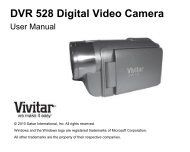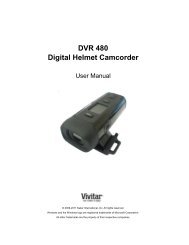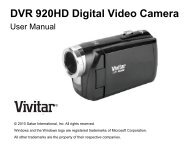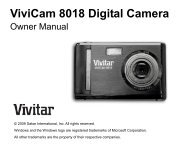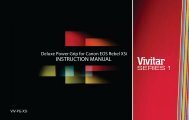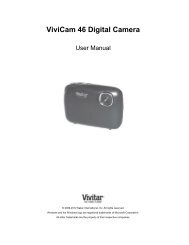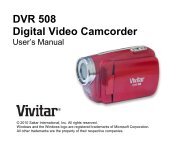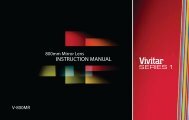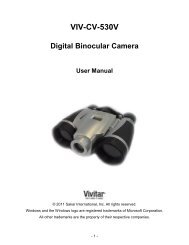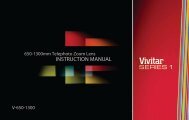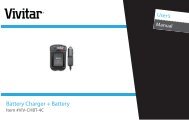INSTRUCTION MANUAL - Vivitar
INSTRUCTION MANUAL - Vivitar
INSTRUCTION MANUAL - Vivitar
Create successful ePaper yourself
Turn your PDF publications into a flip-book with our unique Google optimized e-Paper software.
WHAT TO DO WHEN SERVICE IS NEEDEDSTEP 1. Package the product and relevant accessories carefully, using ample padding materials and a sturdymailing container to prevent damage in transit.STEP 2. Include in package:a) Evidence of date and place of original purchase (for example, a copy of your sales receipt).b) Detailed description of your problem.c) When possible, a sample evidencing the problem.STEP 3. Return item (insured) to: (in the U.S.):(in the U.K.)<strong>Vivitar</strong>Sakar UKAttn: Technical Support 2D Siskin Parkway East195 Carter DriveCV3 4PE, UKEdison NJ 08817When service is complete, the product will be returned to you shipping prepaid. In the event the product isdeemed to be not faulty or the defect is a result in wear and tear, <strong>Vivitar</strong> may levy a handling charge for thefrom country and State to State thereof. For more information visit our website www.vivitar.comTECHNICAL SUPPORTsupport team members will answer your questions. For phone support in the US please call 1-800-592-9541, in theUK call 0800 917 4831. If you would like to call from anywhere else, please visit www.vivitar.com for your local tollfree number.-2-
A Quick Look at Your Device1. Main mount2. Pitching slim auxlliary knob3. Pitching shaft screw4. Rack and pinion focusing knob5. Eyepiece joint tube6. Thumb nut for sighting scope7. Sighting scope bracket8. Sighting scope9. Eyepiece10. Pitching clamp handle screw11. Left and right blocks12.Pitching shaft13.Main tube14.HorizonaI locking auxiliary screw15.Mount base16.Tripod legs17.Accessory dish-3-
IntroductionThank you for purchasing your 76mm Reflector Telescope. Your telescope is a precisionoptical instrument which you can use to learn more about space, the study of astronomy,and the world around you. Please read this manual before using your flash in order to getthe best results possible.-4-
Assembling Your Telescope1.Remove the tripod legs from the box andextend each of them to a suitable length fromtop to bottom, and then tighten the lockingknob (see fig. 1).-5-
Assembling Your Telescope (continued)2. Connect each leg and the mount base using longscrews and wing nuts (see fig. 2a), but not tighten.3. Stretch out the tripod legs so that you can put theaccessory dish on it, connecting them with short screwsand wing nuts (see fig. 3) . Tighten the wing nuts of thetripod legs.4. Connect the pitching shaft to the main tube using thepitching shaft screw (see fig. 2b) .5. Loosen the left and right blocks on the main tube, andthen connect the main tube to the main mount. Tightenthe right and left blocks (see fig. 2c) and tighten thepitching clamp handle screw (see fig. 2d ).-6-
Factors That Effect Observing Results1. Hot air is always moving through the atmosphere .This motion can cause bad images inhigh power conditions, which is why it is often preferred to observe at several night .2. Hot air on the surface of the earth will also cause waves of the air to make the imagetwisted and crushed . This can make the observing conditions very bad.3. Light pollution : try hard not to use your telescope around street lights , or under yourhome’s lights.4 .Moonlight is another factor that affects tone’s observation , as the full moon or the brightmoonlight will make the stars and the planets nearby dim .5. Be careful not to observe from open windows (or even through closed windows)especially during winter when the temperature outdoors varies greatly compared to thetemperature indoors.6. Clouds in the sky can hinder your observations , but fortunately these clouds will moveoften .7. Heavy fog can make observation impossible.-10-



